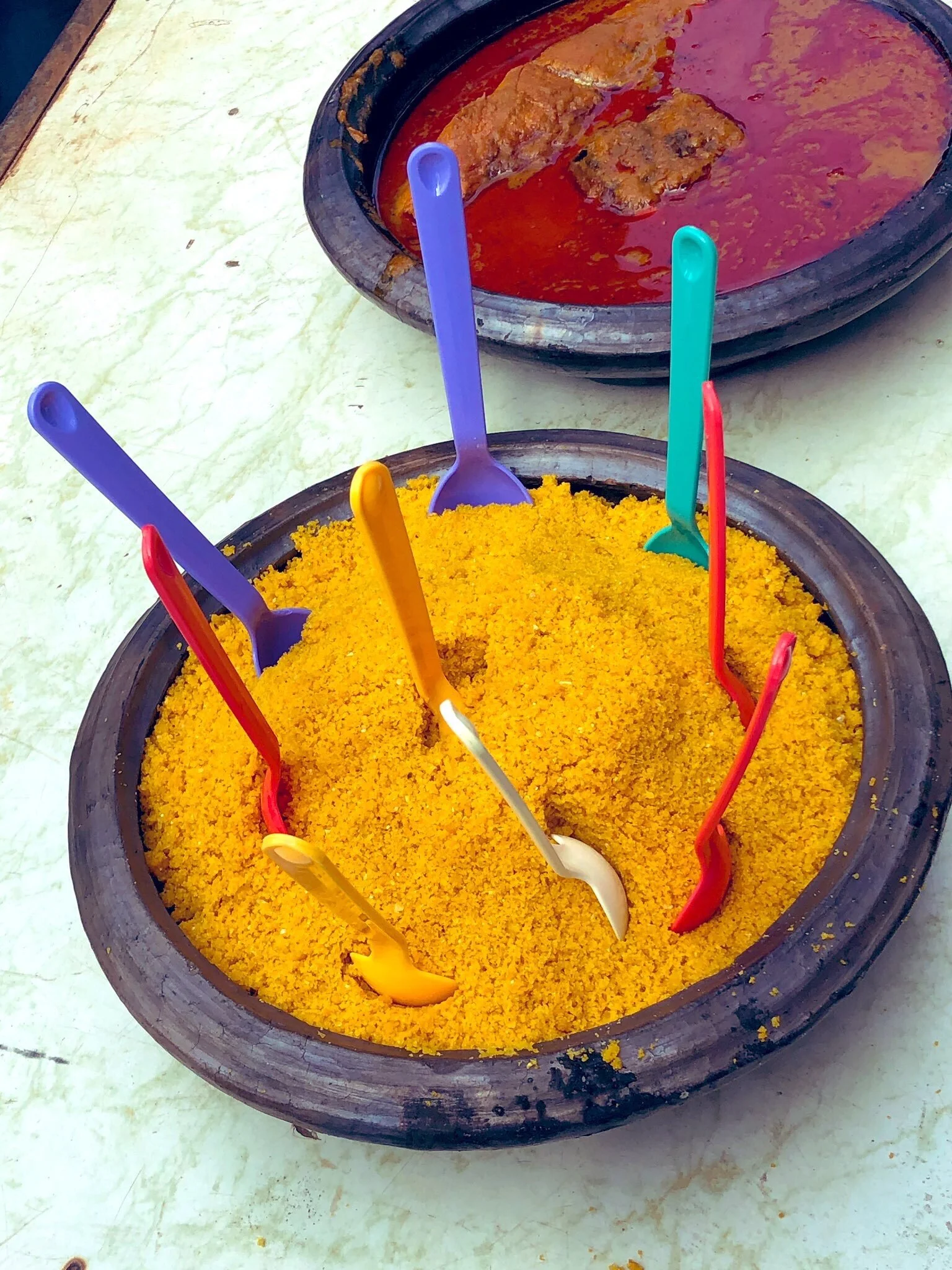The Recipe For Kpokpoi - Homowo Festival Food
“ Afi oo Afi Afi naa akpe wɔ Afi aya ni eba nina wɔ Kpaanyɔ anina wɔ Wɔ fee moomo Wɔ ye Gbo, wɔ ye Gbiεna Al>nte diŋ ko akafo wɔteŋ Atswa akpe, wɔ nɔ bε mli Kpaŋ fεε kpaŋ ni wɔgblaa, aba shwie wɔ hiε Kε wɔje bu lε, wɔje nu n>. Kε wɔyε nu wɔnu lε, wɔ koji anɔ ajɔ wɔ Ni nyεmi afee nyεmi Ni wɔsεε afi lε wɔ hi wala mli lolo Ni wɔsεε afi lε ahi aha wɔ fe nεkε Jɔɔmɔ, Hewalε, Shweremɔ, Shika, Nɔyaa, Kunimyeli afee wɔ fεε wɔ nɔ!🙏 Tswa ni Omanye Jurɔ abla wɔ!😀”
I used to hate the early morning ‘teeshi’ wakeup call from my Grandma on Homowo day. Why did we have to wake up with the cockerels at 4am? It was only much later in my slightly adult-years did I realise why before I stopped my grumbling. If you don’t start early, the kpokpoi will not be ready by lunch time and hungry relatives will be trooping into the kitchen to peek into the palm-nut soup cauldron whilst exclaiming, ‘ niyeni be ko lo?’ Kpokpoi is delicious and even more delicious the next day when it’s dry toasted.
Just like that and another Homowo festival season is here. The Ga Mashie Homowo although celebrated was slightly minimised on celebrations due to the covid-19 pandemic. Last year’s festival was super lit and exciting during the #EatingAccraHomowo food tour through Jamestown.
#EatingAccraHomowo
We experienced how kpokpoi is prepared from when the corn is freshly milled, steamed and then to the final sharing, plating and dining. Good times.
Read more about the history of Ga Homowo and why Kpokpoi is prepared and sprinkled here.
I had hoped to share a video recipe but early motherhood :D so here’s my recipe on how to cook kpokpoi / kpekple .
The preparation of Kpokpoi although lengthy because of the quantities prepared is actually very easy and you can easily cook it at home. If you are abroad and living in a remote part of the UK or USA where the nearest Ga relative or friends is possibly hundreds of miles away, then you should read on and definitely try this at home.
Traditional kitchen appliances used during the preparation of Kpokpoi are the wooden mortar and pestle for pounding the steamed corn, dads3n (metal cauldron), about a yard of ‘mosquito’ net, clay pot steamer and the wooden sieve. If you don’t have these at home you can substitute the clay pot steamer with your rice cooker, the net with a cheesecloth and the wooden sieve with a rectangular metal sieve.
Traditional Clay Steamer
The ingredients for making Kpokpoi are simple and few; ground corn/maize, palm-oil, onions, salt and in some Ga houses there’s the inclusion of okra which is optional.
Preparing Okro for Kpokpoi
Preparing the corn
Let’s start first with how the corn is prepped and the quantity you need. If you are preparing a meal for a family of 3 or 4 individuals then half-olonka is sufficient. Half-olonka is roughly about 6 cups of corn. If you can’t send the corn to the mill like we do in Ghana, then you can try using cornmeal but I have never used cornmeal in preparing Kpokpoi before as cornmeal is purely dried milled corn. The difference is that Kpokpoi corn is soaked overnight for hydrating the corn. Perhaps masa corn will do? So back to preparing the corn. Wash it to get rid of impurities about 4-5 times until the water becomes clear. Fill the container until water covers the top of the grains. The next morning, pour out the water and have it sent to the mill in your neighbourhood. It’s such a blessing to have a local mill in your area, eh! Even if it’s 5km away like mine is. Once it’s milled you have to use it immediately to prevent fermentation. Some people sieve the milled corn, others go straight ahead to the steaming process.
Steaming the corn
Once your corn is milled, it’s time to steam it. Like I said earlier, you can absolutely use a rice cooker to steam your milled corn using the steamer basket which comes with your rice cooker. Hopefully you haven’t disposed of it. hehe! It’s such a useful part of the rice cooker for steaming vegetables, fish and dumplings.
Fill the rice cooker with water to about half-way and place the steamer basket above it, spread your cheesecloth/ mosquito net into the basket and pour the milled corn into the basket to cover every corner and space. Cover the top part with the lose ends of the net or cloth. Flip the switch on the rice cooker to COOK. How to tell if it’s steaming? The signs of rising steam is your evidence. Allow to cook for 10mins.
Preparing the PalmOil
Palm oil renders the yellowish-orangish color to Kpokpoi and we flavour it with onions, shrimp or dried fish. Go with whichever you have available. Chop up one onion. Heat about 1 cup of palm oil in a small saucepan and add onions, allow onions to caramelise to flavour the oil. Set aside. Also add about 1 teaspoon of salt to 1/2 cup of water to make salted water which will be sprinkled onto the steam corn before pounding.
Pounding the Kpokpoi
Check on the steaming corn. The corn should have a cooked and slightly thickened texture. Once you see this, pour out into your mortar, add the salted water by sprinkling a few teaspoons at a time. Sprinkle the palm oil onto the corn and start pounding. The amount of palm oil will depend on how you like your Kpokpoi to look. You can also add the palm oil which rises from the palm-nut soup as your colorant. This renders a stronger flavour as well. In the event that you don’t have a mortar, trust me on this, use an asanka bowl and the tapoli. This works only if you are preparing a meal just for yourself or else you will get tired soon. Pound the palmy cornmeal until the oil is well-incorporated into the corn. It takes less than 5mins to pound if it’s not much corn. Pour out into a bowl.
Traditional pounding of Kpokpoi
You can choose to add cooked and chopped okra at this stage as a thickener but it’s very optional.
Sieve the pounded kpokpoi using the wooden sieve or a rectangular metal sieve if you can find one. Sieving the Kpokpoi makes it finer and separates the rough clumps from the others. The clumps can also be pounded again and further sieving done to extract more finer grains.
That’s it! Dig in with your already cooked palm-nut soup. But don’t forget to leave some to dry toast the next day. That’s the best one isn’t it?
Even if you don’t cook this at home, I hope you have picked some insights into the the preparation of Kpokpoi. Stay safe guys!













